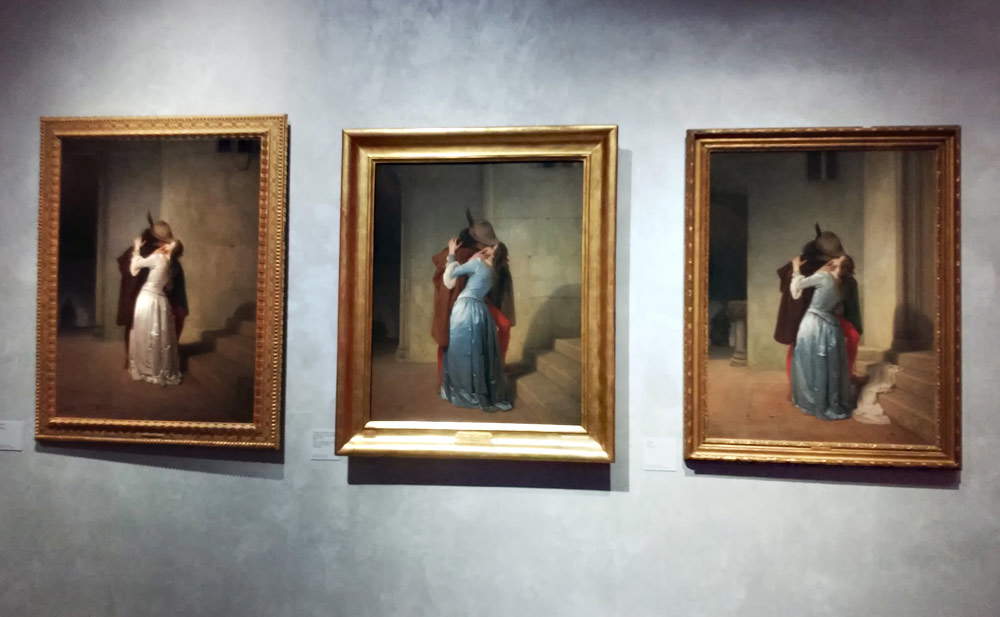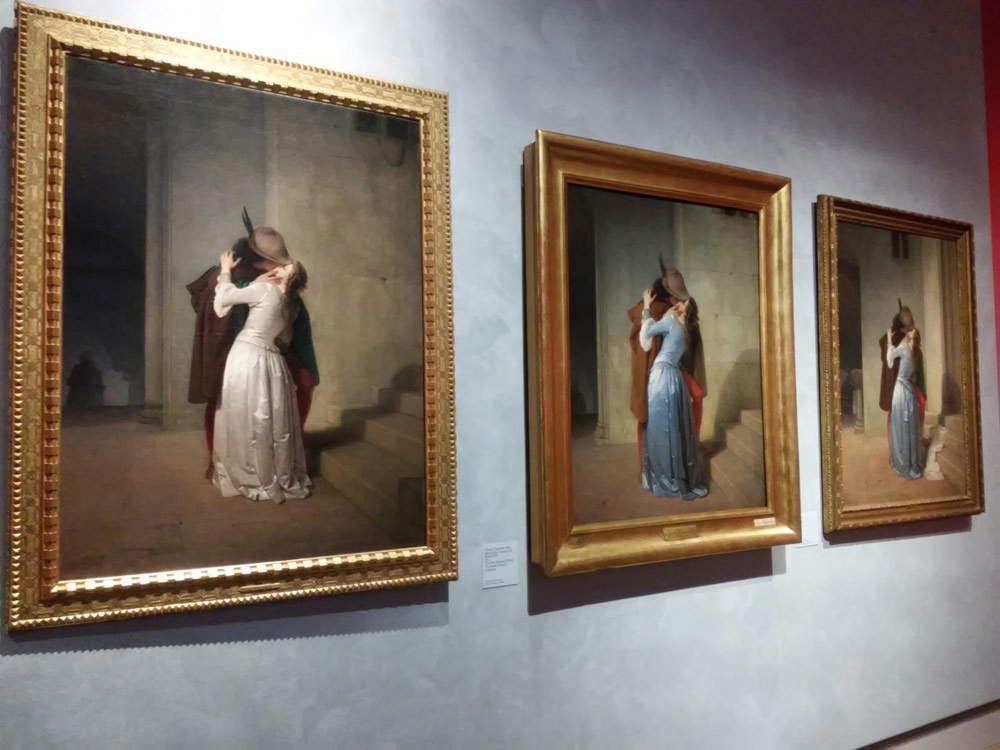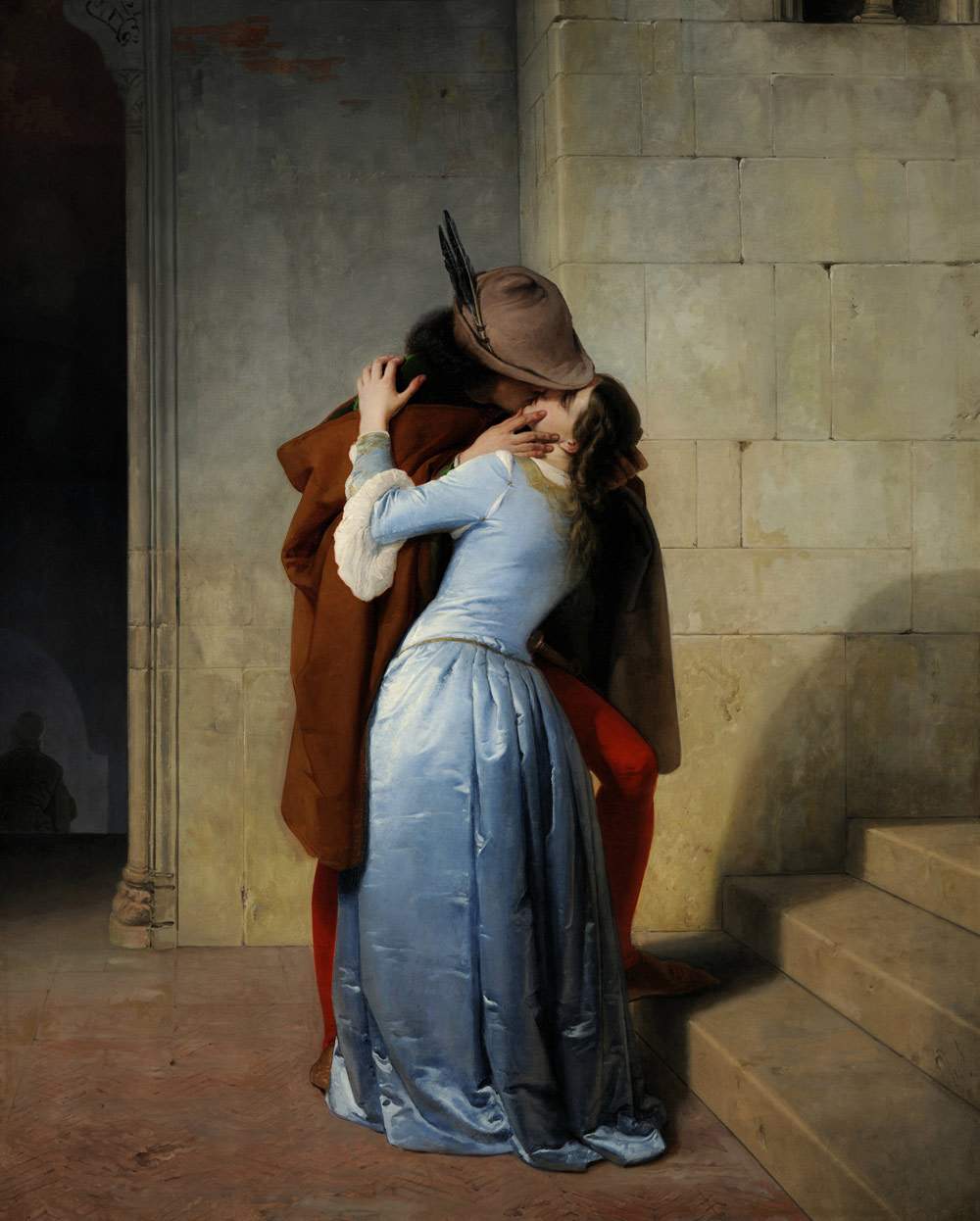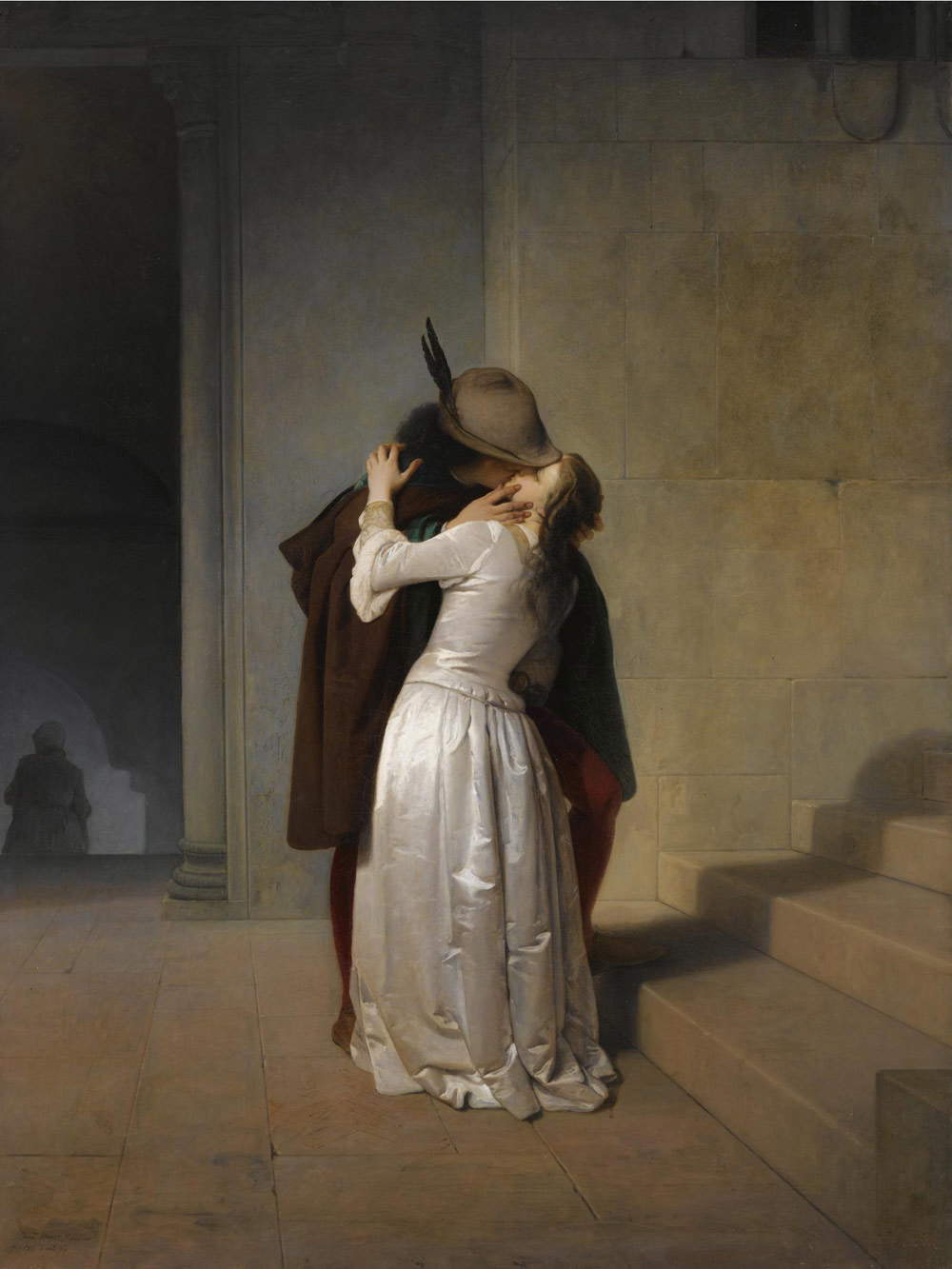Francesco Hayez's The Kiss: how many and what are the versions?
One of the most striking moments of recent exhibition seasons in Italy was the simultaneous presence on the same wall in Milan of three versions of the Kiss, one of the most famous paintings by Francesco Hayez (Venice, 1791 - 1882), the great genius of Italian Romanticism. The opportunity to see the three works reunited was offered by the major exhibition, entirely dedicated to Hayez (and titled, precisely, Hayez), held in late 2015 of 2016 at the Gallerie d’Italia in Milan’s Piazza Scala. However, the exhibition of the three “kisses” generated (and still generates) some confusion about the exact number of versions of the Kiss known today. How many and what, then, are the known versions of the celebrated work?
 
|
| The three versions of Francesco Hayez ’s Kiss on display in Milan between 2015 and 2016 |
Let’s go in order. The first version (the original, if we prefer) is the painting that is now in the Pinacoteca di Brera. It was executed in 1859 for a nobleman, Count Alfonso Maria Visconti di Saliceto, who belonged to a secondary branch of the family that ruled the fortunes of the Duchy of Milan between the thirteenth and fourteenth centuries, and was first exhibited in an exhibition that opened at the Brera Academy (we are still in Milan) on September 9, 1859, three months after Vittorio Emanuele II entered the city during the Second War of Independence. The title under which the work was presented was somewhat different from the “shortened” one with which we know it today: the painting was in fact exhibited as The Kiss. Episode of Youth. Costumes of the 14th Century. A title certainly enigmatic, exactly like the meaning of the painting itself. Reference was made to a “youth”: but whose, it was not known. Equally vague was the allusion to the “14th century.” The only thing clear to everyone was the action performed by the two protagonists: a kiss. Yet it was also (and perhaps above all) this underlying ambiguity that ensured immediate success for a work that, in the midst of paintings of predominantly military subject matter (the Second War of Independence had recently ended, with the decisive victory of the Sardinian-French axis, and the artists intended to pay homage to the event with typical Risorgimento rhetoric), had resoundingly distinguished itself by standing outside of convention. Nevertheless, Francesco Hayez’s happy insight (it is to him that the idea for the Kiss is attributed) was to cloak the work in a veiled political significance. Political interpretation of the painting had already spread during the Risorgimento era: in 1872, writer Federico Dall’Ongaro called it Il bacio del volontario (it is well known that many very young volunteers had participated in the Battle of Curtatone and Montanara during the First War of Independence).
But this was not Hayez’s only merit: as art historian Fernando Mazzocca (one of the leading experts on Hayez’s art) wrote in a recent contribution, the idea “of representing the most intense and poetic moment of the relationship between two people who love each other, managing to render so immediately and convincingly all its fascination and mystery” succeeded in penetrating the souls of observers to the point of making the painting anicon whose effectiveness persists to this day. Few indeed remain insensitive to the attraction exerted by the kiss of the two young protagonists, a kiss so sensual, heartfelt, passionate, natural. Such an attraction should not have left indifferent even the director Luchino Visconti, who decided to evoke the work in the scene of the film Senso in which the last kiss between the two protagonists is consummated: a choice, that of Luchino Visconti, which undeniably contributed to the painting’s fame. This first Kiss by Hayez reached the Pinacoteca di Brera in 1886 with the legacy of Count Visconti di Saliceto, who arranged for it to be exhibited to the public: however, since 1859 the work’s success was such that Hayez was immediately asked for several replicas.
 |
| Francesco Hayez, The Kiss (1859; oil on canvas, 112 x 88 cm; Milan, Pinacoteca di Brera) |
Let’s start with the two that were present at the Milan exhibition. The one from 1861, kept in a private collection and easily recognizable because the girl is wearing a white dress (which compared with the young man’s green cloak and red tights has given rise to interpretations about a possible allegory of the Italian flag), is signed and dated and was painted for Swiss-born entrepreneur Federico Mylius, as we know from documents of the time. It came up for auction at Sotheby ’s in 2008, when it was sold for just under eight hundred thousand euros-a record that stood until April 2016, when the third version displayed in the Gallerie d’Italia exhibition was sold in an auction at Christie’ s in New York for the sum of $1.865 million. This version, which is further distinguished from the other two by certain details (the veil thrown over the steps, the mullioned window in a more central position, the half-column behind the protagonists), was painted in 1867 to be shown at theUniversal Exhibition in Paris that year. Interestingly, the 1867 version was probably the one Hayez was most fond of, because he did not want to give it to anyone, and it remained his property until his death. His heirs then sold it to the Grand Duchess Elena Romanova, niece of Tsar Alexander III of Russia: through hereditary ways it finally passed to collectors who decided to have it auctioned in 2016.
 |
| Francesco Hayez, The Kiss (1861; oil on canvas, 125 x 94.5 cm; Private collection) |
 |
| Francesco Hayez, The Kiss (1867; oil on canvas, 118.4 x 88.6 cm; Private collection) |
In addition to the three versions exhibited in Milan between 2015 and 2016, there are other lesser-known versions, but which have nonetheless been tracked down by scholars and identified, on a documentary basis, as replicas executed by Hayez’s hand. Art historian Sergio Coradeschi, in his book L’opera completa di Hayez (from the Rizzoli Classics series), gave an account of four versions of the painting: three are the ones we have already mentioned (the original now in Brera, the former Mylius version and the 1867 version). The other would be a version that belonged to one of Hayez’s mistresses, Adele Appiani (niece of Andrea, a famous neoclassical painter): passed to the tenor Angelo Masini, it probably ended up for sale at the Scopinich Gallery in 1926. Traces of this version would be lost. Again, in the catalog of Hayez’s works compiled in 1994 by Mazzocca, the scholar spoke of another version from 1859, smaller in size (55 x 40 cm) than the other known ones, which would have belonged to the family of another lover of the painter, Carolina Zucchi, and would still be in the possession of the woman’s heirs (the work would be in Turin).
So we have some elements to answer the question posed in the title of the article: how many versions do we know of Hayez’s Kiss? Five in all, one of which, however, turns out to be untraceable: the number of versions whose location we know would therefore be reduced to four (and four is also the number proposed by the Sotheby’s catalog for the 2008 sale mentioned above). Alongside these versions, all in oil on canvas, there would nevertheless be others done in watercolor: Coradeschi speaks of them in the plural, without however specifying a number. We know that there is a watercolor of the Kiss in a private collection (it was owned by the Trentino poet Andrea Maffei, a friend of Hayez), and above all we are familiar with the one in the Pinacoteca Ambrosiana in Milan, which once belonged to the Negroni Prati Morosini family (they were wealthy patrons of Hayez): it was part of the family’s legacy, which, in 1962, entered the Ambrosiana collection. However, these are not studies for the final realization of the painting, but rather works later derived from a painting that was particularly successful (a not uncommon case in Hayez’s production).
A success that, as we have seen, led the artist to execute a number of replicas of the painting. Will those of which we have news really be all that the artist made? Who knows: will there be others that we do not know about? The odds are very slim, of course: but art history always holds surprises.... !
Reference bibliography
- Fernando Mazzocca (ed.), Hayez, exhibition catalog (Milan, Gallerie d’Italia di Piazza Scala, November 7, 2015 - February 21, 2016), Silvana Editoriale, 2015
- Maria Vittoria Marini Clarelli, Fernando Mazzocca, Carlo Sisi (eds.), Ottocento: da Canova al Quarto stato, exhibition catalog (Rome, Scuderie del Quirinale, February 29 - June 10, 2008), Skira, 2008
- Fernando Mazzocca, Private Hayez: art and passions in romantic Milan, Allemandi, 1997
- Fernando Mazzocca, Francesco Hayez. Catalog raisonné, 24 Ore Cultura, 1994
- Sergio Coradeschi, The Complete Works of Francesco Hayez, Rizzoli, 1971
Warning: the translation into English of the original Italian article was created using automatic tools. We undertake to review all articles, but we do not guarantee the total absence of inaccuracies in the translation due to the program. You can find the original by clicking on the ITA button. If you find any mistake,please contact us.





























